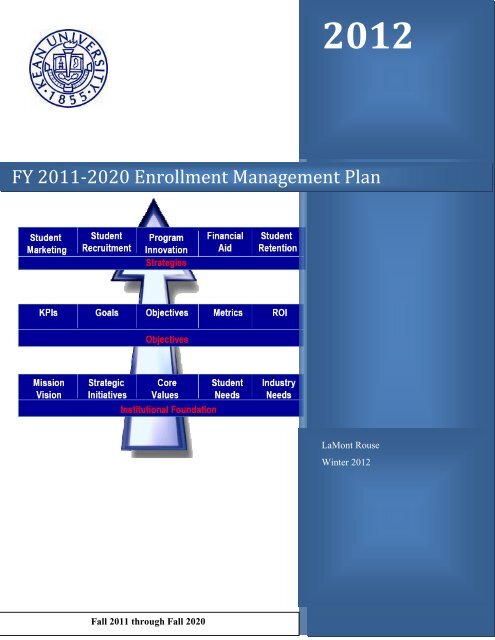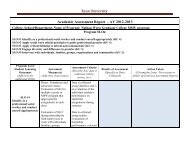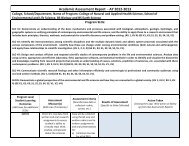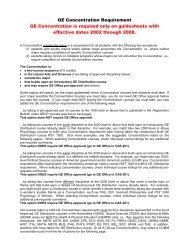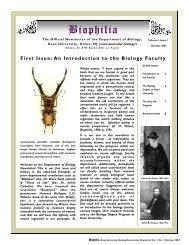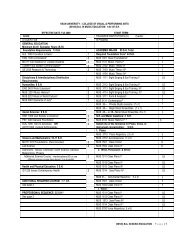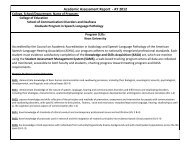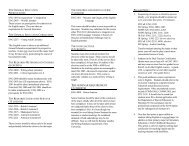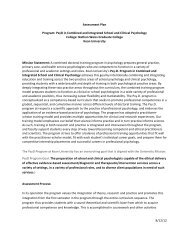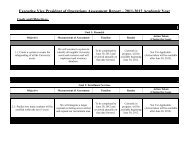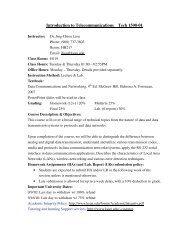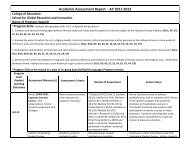Enrollment Management Plan - Kean University
Enrollment Management Plan - Kean University
Enrollment Management Plan - Kean University
You also want an ePaper? Increase the reach of your titles
YUMPU automatically turns print PDFs into web optimized ePapers that Google loves.
2012<br />
FY 2011-2020 <strong>Enrollment</strong> <strong>Management</strong> <strong>Plan</strong><br />
LaMont Rouse<br />
Winter 2012<br />
Fall 2011 through Fall 2020<br />
1
Summary<br />
The following report provides an overview of <strong>Kean</strong>’s Strategic <strong>Enrollment</strong> <strong>Management</strong> <strong>Plan</strong> (EMP), which<br />
will move <strong>Kean</strong>’s current enrollment from 15,900 (fall 2010) to 20,000 (Fall 2020). The overall headcount in<br />
2015 is projected to be 25% higher than in fall 2010 and 67% higher than in fall 2000. <strong>Kean</strong> <strong>University</strong>’s EMP<br />
is based on modest assumptions and looks to capitalize on several strategic areas of growth, including <strong>Kean</strong>-<br />
Ocean, areas where the <strong>University</strong> is under enrolled (Nathan Weiss Graduate College), new forms of<br />
technology (online courses), and additional weekend and evening program and course offerings.<br />
A coalition of administration, staff, and faculty was tasked with leading an enrollment effort at <strong>Kean</strong> in 2010.<br />
Since the fall of 2010, the <strong>Enrollment</strong> <strong>Management</strong> Group has grown to include an ongoing committee that<br />
attempts to project enrollment and synchronize administrative efforts and is tasked with leading the <strong>University</strong>’s<br />
assessment efforts, particularly in monitoring ongoing trends. The following <strong>Enrollment</strong> <strong>Management</strong> <strong>Plan</strong><br />
describes the strategies, metrics, and rationales that will lead <strong>Kean</strong>’s efforts in the next five years.<br />
<strong>Kean</strong>’s Strategic <strong>Enrollment</strong> <strong>Management</strong> <strong>Plan</strong> is inclusive but by no means exhaustive of all activities that will<br />
be done on campus. Indeed, external forces will continue to impact the <strong>University</strong>’s ability to reach out, and<br />
funding could also have an impact. Nonetheless, we are confident that between now and 2015, <strong>Kean</strong>’s robust<br />
enrollment will continue as it seeks to improve its entering student profile.<br />
The <strong>University</strong> is striving to become a world-class institution, and this report continues to build on the mission.<br />
In this report, you will find distinct directions, key indicators, and measurable goals and objectives along with<br />
strategies for achieving this ambitious agenda. <strong>Kean</strong> <strong>University</strong> is prepared to meet the additional needs of the<br />
students through a Faculty Replenishment <strong>Plan</strong> that will increase faculty numbers by 37% (n = 450).<br />
Highlights<br />
<strong>Kean</strong> <strong>University</strong> will grow its overall enrollment by 25% from fall 2010 through fall 2020, with an<br />
overall enrollment of 20,000.<br />
The headcount in the graduate school is projected to increase by 33% (n = 4,000).<br />
The <strong>Kean</strong>-Ocean campus is expected to grow aggressively by 127% (n = 2,500) from fall 2010’s<br />
headcount of 1,100.<br />
The anticipated growth in the <strong>Kean</strong> <strong>University</strong> main campus undergraduate headcount is 12.5%.<br />
Growth will be achieved through improved targeted marketing, better retention efforts, and strategic<br />
partnerships with industries.<br />
Growth caps will be placed on specific programs due to market needs and/or internal human resource<br />
limitations.<br />
2
Introduction<br />
<strong>Kean</strong> <strong>University</strong> was founded in 1855 as a normal school. It is a state-supported coeducational institution of<br />
higher education within the New Jersey State college system. <strong>Kean</strong> is fully accredited by the Middle States<br />
Association of Colleges and Schools and by numerous specialized accrediting groups, including the National<br />
Council for Accreditation of Teacher Education.<br />
An important part of the university’s mission statement reads, ―<strong>Kean</strong> is an interactive university, and the<br />
<strong>University</strong> serves as a major resource for regional advancement.‖ Since 2003, <strong>Kean</strong> <strong>University</strong> has been<br />
dedicated to transforming its campus. The physical plant has added several buildings, increasing the number of<br />
classrooms by over 40%. This expansion has helped serve the ever-increasing student population, which now<br />
totals 16,000 undergraduate and graduate students. <strong>Kean</strong> is now the third largest public institution in the state of<br />
New Jersey.<br />
The growth at <strong>Kean</strong> does not signal a change in its outlook. Indeed, the expansion and beautification are<br />
extensions of its current mission: to provide world-class education that strives for both excellence and<br />
accessibility. <strong>Kean</strong> remains committed to providing educational opportunities throughout New Jersey. This<br />
expansion includes new educational offerings at Ocean County College, Raritan Valley Community College,<br />
Middlesex County College, and various other sites.<br />
<strong>Enrollment</strong> growth since 2003 has been impressive, and the <strong>University</strong> has broken enrollment records for three<br />
years in a row. For fall 2000, the <strong>University</strong> had a headcount of 11,468; in fall 2010, the <strong>University</strong>’s headcount<br />
topped 15,900. Growth in the <strong>University</strong>’s graduate programs, however, has been stagnant, with a headcount of<br />
approximately 3,000 since 2005. The <strong>University</strong> is positioned to reach 20,000 students by the year 2015,<br />
including 3,300 to 4,000 graduate students and 1,500 additional students at <strong>Kean</strong>-Ocean.<br />
<strong>Kean</strong> <strong>University</strong>’s EMP is based on some simple assumptions that the <strong>University</strong> is under enrolled in several<br />
areas. While <strong>Kean</strong>’s main campus of undergraduate students is nearing capacity, there are several strategic<br />
opportunities for growth. First, <strong>Kean</strong> is building a new 100,000-square-foot facility that will serve<br />
approximately 2,500 students in 2015. Second, the Nathan Weiss Graduate College has conducted virtually no<br />
ongoing or strategic marketing. Third, fewer than 2% of all of <strong>Kean</strong>’s courses are offered in an online or hybrid<br />
format. Fourth, while <strong>Kean</strong>’s weekend course offerings have increased, they are still in a nascent state. In<br />
addition, weekend programming does not include programs that could more readily build higher enrollment.<br />
Finally, <strong>Kean</strong>’s global reach is continuing, with opportunities for growth from international students. This<br />
includes strategic agreements with universities in France, Germany, Bangladesh, Brazil, and China, to name a<br />
few.<br />
The following report presents the goals, objectives, strategies, and tactics that will be used to build <strong>Kean</strong>’s<br />
enrollment. The report will inform decision-making and budgeting and serve as a guide for activities. One of<br />
<strong>Kean</strong>’s greatest challenges is accomplishing these tasks when facing ongoing budget constraints. We are<br />
committed to collaborating with various constituents, aggressively exploring outside funding resources, and<br />
finding efficiencies. Together we will strengthen our resolve to attract and retain students and faculty and grow<br />
in areas needed by industry. <strong>Kean</strong> <strong>University</strong> views this report as a continuation of our neverending service to<br />
the state of New Jersey.<br />
3
Purpose<br />
The purpose of the Strategic <strong>Enrollment</strong> <strong>Management</strong> Report is to propose a series of ongoing and continuous<br />
activities that will allow the <strong>University</strong> to make better data decisions and to gather empirical evidence of its<br />
future enrollment profile. Data gathered in this report have been compiled from the Office of Institutional<br />
Research, the Office of Accreditation and Assessment, and the Office of Computer Information Systems. The<br />
enrollment plan is consistent with the <strong>University</strong>’s mission to achieve both access and excellence.<br />
Institutional Foundations<br />
The <strong>Kean</strong> <strong>University</strong> Strategic <strong>Enrollment</strong> <strong>Management</strong> <strong>Plan</strong> is based on five core institutional foundations: the<br />
<strong>University</strong>’s mission and vision, the 2007-2012 Strategic <strong>Plan</strong>, <strong>Kean</strong>’s core values, student needs, and industry<br />
needs. Below, we provide an overview of each of these foundations.<br />
Mission & Vision<br />
The mission of <strong>Kean</strong> <strong>University</strong> attempts to balance access and excellence. <strong>Kean</strong> views itself as a studentcentered<br />
cosmopolitan institution with a focus on serving a diverse student body and preparing students to enter<br />
into a global society (for a complete copy of the mission statement, please see attachments).<br />
<strong>Kean</strong> <strong>University</strong> is a public cosmopolitan university serving undergraduate and graduate students in the<br />
liberal arts, the sciences, and the professions. The <strong>University</strong> dedicates itself to the intellectual, cultural,<br />
and personal growth of all its members—students, faculty, and professional staff. In particular, the<br />
<strong>University</strong> prepares students to think critically, creatively, and globally; to adapt to changing social,<br />
economic, and technological environments; and to serve as active and contributing members of their<br />
communities. – <strong>Kean</strong> Mission Statement (first paragraph)<br />
<strong>Kean</strong>’s mission statement details its aspirations toward learning outcomes and expansion in emerging markets,<br />
specifically by focusing on recruiting additional international students. <strong>Kean</strong>’s vision statement is embedded in<br />
its mission of aspiring to be a world-class institution as demonstrated by having distinguished faculty and<br />
excellence in student outcomes.<br />
4
<strong>Kean</strong> <strong>University</strong> 2007-2012 Strategic <strong>Plan</strong><br />
The KU 2007-2012 Strategic <strong>Plan</strong>, Reaching Toward Excellence, is based on ten strategic initiatives designed to<br />
reposition <strong>Kean</strong> while remaining true to its original mission as a teacher’s college designed to increase learning<br />
opportunities for a diverse world. The three core challenges are reaching excellence, strengthening the campus<br />
community, and strengthening the campus infrastructure (for a copy of the ten strategic directions, please see<br />
attachment).<br />
I. Accountability and Assessment<br />
VI. Commitment to Diversity<br />
II. Academic Initiatives<br />
III. External Partnerships<br />
VII.<br />
VIII.<br />
Financial Infrastructure<br />
Physical Infrastructure<br />
IV. Attracting & Retaining Students<br />
V. Attracting & Retaining Faculty-Scholars<br />
IX. Technological Infrastructure<br />
X. Adaptability & Responsivity<br />
<strong>Kean</strong>’s Strategic <strong>Plan</strong> has several areas of focus with the same theme: improvement. <strong>Kean</strong> seeks to advance its<br />
student and faculty profile while continuing to upgrade campus technology and its physical plant.<br />
Core Values<br />
<strong>Kean</strong> <strong>University</strong>’s core values include personal responsibility, respect for diversity, civic and social<br />
engagement, and lifelong learning. The <strong>University</strong>’s mission specifically focuses on producing global citizens<br />
that can adapt to change. Indeed, these values are needed in today’s environment, where there is considerable<br />
change and uncertainty in domestic affairs. The core learning values of the institution are embedded in our<br />
general education courses and measured at various intervals.<br />
Students’ Needs<br />
Since 2003, the administration of Dr. Farahi has produced something he calls the Galileo effect. This describes<br />
a paradigm shift that has occurred under the administration. In the old paradigm, the <strong>University</strong> operated around<br />
the interest groups as the center of the universe. Today, the procedures are designed to focus on students’ needs,<br />
including the following:<br />
1) Preparing students to succeed from day one (including creating a four-year graduation plan).<br />
2) Offering quality academic advising to assist students with making significant progress toward their<br />
academic objectives.<br />
3) Improving the <strong>University</strong>’s retention and intervention programs.<br />
4) Delivering quality courses and services throughout the week. This includes significantly expanding<br />
course offerings during the evenings and weekends.<br />
5) Expanding opportunities for online learning.<br />
5
Industry Needs<br />
New Jersey’s economy is expected to grow by about 3.5% in the coming years, and there are special needs in<br />
the areas of math, science, and technology. According to the New Jersey Department of Labor, industries<br />
specializing in these disciplines are expected to experience an annual growth rate of 8%. In addition, the New<br />
Jersey Department of Labor projects that nearly 30% of all teachers will retire in the next five years. Finally,<br />
New Jersey’s economy is growing fastest in areas that require additional training beyond the high school level.<br />
Over 70% of the fast-growing, high-paying jobs in the state will require at least a bachelor’s degree, and many<br />
expect additional training beyond that level.<br />
By the Numbers<br />
The following section provides an overview of the projected growth in major categories. These figures are<br />
prospective and based on strategic opportunities for growth.<br />
Quick note: The <strong>University</strong>’s figures are based on aggressive growth, yet they remain realistic because of the<br />
strategic opportunities. Growth is based in part on new opportunities and markets and increased retention rates.<br />
The <strong>University</strong>’s four-year graduation rate is expected to increase over the next four year and double to nearly<br />
40% in FY 205 where it would be a leader amongst the New Jersey public college sector. Headcount growth in<br />
this plan is based on improving advising, mentoring and student support.<br />
6
Quick note: A 30-million-dollar, 100,000-square-foot facility is being developed on the campus of Ocean<br />
County College in Toms River, New Jersey. The building’s anticipated completion date is 2013, and projected<br />
growth is expected to boom once it is completed. Today, <strong>Kean</strong>-Ocean students are sharing a facility with Ocean<br />
County Community College, and even within this constricted space, <strong>Kean</strong> has over 1,100 students. The<br />
projected transfer rate to <strong>Kean</strong>-Ocean from Ocean County is anticipated to be about 20% to 25% of all<br />
graduates, and Ocean averages approximately 1,000 graduates per year.<br />
Student Profile<br />
In the <strong>Enrollment</strong> <strong>Management</strong> <strong>Plan</strong>, <strong>Kean</strong> anticipates increasing the number of first-time, full-time<br />
students from 1,700 in fall 2010 to 1,900 by fall 2015. The mean SAT of 1025 and high school GPA of 3.1 for<br />
all regular undergraduate admits are expected to edge to 1040 and 3.25 by fall 2015. The increase will be due to<br />
the larger number of applicants versus the number of seats offered. New regions, including the shore counties,<br />
will be targeted for growth. Approximately two-thirds of all first-year students will gain admittance through<br />
regular admissions.<br />
<strong>Kean</strong> will continue to stay true to its mission as an opportunity institution, and will continue to recruit<br />
populations that have been traditionally underrepresented in higher education. All of these programs will be<br />
consolidated into a new office called the Center for Educational Opportunity (CEO). Admission standard<br />
metrics for these programs will be a minimum high school GPA of 2.3 and SAT score of 720 (math and verbal).<br />
In investigations of first-year students at <strong>Kean</strong>, we find considerable attrition and significantly higher rates of<br />
academic probation when students fail to meet these minimum benchmarks. While reaching toward opportunity;<br />
however, these programs will also focus on recruiting an improved profile. It is anticipated that the mean<br />
7
metrics for all CEO cohorts by FY 2015 will be a high school GPA of 3.0 and a combined math and verbal SAT<br />
score of 890. An estimated 450 first-time students will be admitted into one of <strong>Kean</strong>’s CEO programs each year.<br />
Transfer admission represents a strategic opportunity for growth. The <strong>University</strong> currently admits<br />
roughly 1,000 transfer students each year. Given the anticipated opening of <strong>Kean</strong>-Ocean in 2012/13, the<br />
establishment of a weekend college, and improved targeted marketing, we should see an increase in annual<br />
transfer students from 1,000 to 1,700 by FY 2015.<br />
Programs of Study<br />
<strong>Kean</strong> <strong>University</strong> has traditionally allowed undergraduate students to choose their programs of study<br />
without restrictions, although there are a few high-achieving programs that require a specific set of admissions<br />
criteria. A growing number of majors, specifically those related to education, now require minimum GPAs<br />
before entering into the discipline. The <strong>University</strong> has tried to meet student demands by expanding human<br />
resources in these areas. While this approach will still be used for more of the programming operations, the<br />
<strong>Enrollment</strong> <strong>Management</strong> <strong>Plan</strong> calls for promoting certain majors and capping enrollment for others. The<br />
rationale for expanding and restricting majors is based partly on internal human resource capacities, but mostly<br />
on external environmental scans that look at career prospects.<br />
Majors and Caps<br />
The following majors will have caps placed on them. The various vice presidents, deans, and executive<br />
directors will be responsible for ensuring the integrity of the caps and assisting students during this process.<br />
Undergraduate Psychology: Undergraduate psychology, the largest major at the <strong>University</strong>, has grown by<br />
more than 35% to 1,101 in the last four years. Given our internal capacity, <strong>Kean</strong> has chosen to cap enrollment at<br />
1,100. A reassessment of this cap will occur during the cycle, probably during FY 2013. The <strong>University</strong> has set<br />
an internal indicator of providing more than 65% of all third- and fourth-year courses with resident faculty. If<br />
that outcome remains elusive, then the cap will be lowered to ensure that students can be served by more fulltime<br />
faculty, especially at those levels.<br />
Undergraduate Criminal Justice: The criminal justice program has grown to 768 majors in fall 2010,<br />
representing a 44% growth in four years. This type of growth is difficult to manage, and as such, more attention<br />
will be given to actively managing the situation. The <strong>University</strong> will cap enrollment for this discipline at 900.<br />
Undergraduate Physical Education: Another emergent major is physical education, which has grown by 56%<br />
in the last four years to 690 students (fall 2010). The new physical education enrollment target is 550, for a<br />
targeted reduction of approximately 20%. Given the students in the queue, we forecast graduation figures<br />
between 100 and 120 through FY 2014. Our marketing scan suggests that students with this major will have the<br />
most difficulty entering the workforce. The <strong>University</strong> is attempting to ameliorate the issue by expanding its<br />
service area to other parts of New Jersey as well as entering into agreements with neighboring states.<br />
8
Majors Targeted for Growth<br />
The following majors will be targeted for growth and will have access to a special fund that allows them to be<br />
featured in various advertising campaigns.<br />
Undergraduate and Graduate Communication: The undergraduate communication program is projected to<br />
grow by 40%; given our proximity to New York City and Philadelphia, along with the extensive network of<br />
companies and media outlets in New Jersey, this major is primed for growth. We anticipate the number of<br />
undergraduate communication majors to increase to 500 by FY 2015. The graduate communication program<br />
currently has fewer than 20 students, but there are significant strategic opportunities for growth in this area. A<br />
focused push will drive the major to more than 100 students, for a growth of more than 400%, by FY 2015.<br />
Graduate Public Administration: The graduate MPA program is accredited and has some of the strongest<br />
graduate profiles at the <strong>University</strong>. However, enrollment in the program has remained stagnant at between 130<br />
and 160 students for several years. The <strong>Kean</strong> MPA program currently does not have any active outreach<br />
programs and has not targeted various internal constituents. That will change during this enrollment cycle. We<br />
will set an enrollment goal of 250 by FY 2015 for a rise of 78%.<br />
Graduate MBA Program: The graduate MBA program at <strong>Kean</strong> is only five years old and currently has<br />
approximately 100 students, including more than 20% with international student status. The program recently<br />
completed a rigorous international EPAS accrediting process, and it anticipates acceptance into that accrediting<br />
body in the summer of 2011. The program would then become the first internationally accredited MBA<br />
program in the United States.<br />
Undergraduate Finance: The New Jersey Department of Labor projects jobs in the finance field to grow at<br />
rates faster than normal. The finance major is strategically positioned to grow by 30% to 40% (n = 275) through<br />
FY 2015.<br />
Undergraduate Marketing: Job prospects in this discipline are considered healthy, although enrollment at the<br />
<strong>University</strong> has been flat. Specialized advertising materials will be distributed to prospective students to assist<br />
with driving marketing in this area. <strong>Enrollment</strong> is projected to grow to more than 300 students by FY 2015, for<br />
a growth rate of about 60% from fall 2010’s figures (n = 188).<br />
9
Goals<br />
The <strong>Enrollment</strong> <strong>Management</strong> <strong>Plan</strong> is based on four simple goals: recruiting, retaining, expanding course<br />
offerings, and strategic partnerships.<br />
Goal 1: Expand marketing, recruitment, and early outreach strategies.<br />
Goal 2: Enhance academic programs and support systems that foster student persistence and success.<br />
Goal 3: Expand course offerings for working adults and non-traditional populations.<br />
Goal 4: Aggressively pursue strategic partnerships with private-sector businesses.<br />
Goals/Objectives<br />
FY 2010–FY 2015<br />
Goal 1: Expand marketing, recruitment, and early outreach strategies.<br />
Objective 1.1: To create target application goals for high schools in <strong>Kean</strong>’s core enrollment counties (Union and<br />
Middlesex).<br />
Objective 1.2: To expand received applications from new shore county markets (Monmouth and Ocean).<br />
Objective 1.3: To strengthen and expand applications from graduating community colleges.<br />
Objective 1.4: To expand applications from international students.<br />
Objective 1.5: To strategically target senior-level <strong>Kean</strong> students with graduate opportunities.<br />
Objective 1.6: To increase <strong>Kean</strong>’s marketing reach beyond its core service area.<br />
Objective 1.7: To increase <strong>Kean</strong>’s marketing reach into strategic international markets with established links to<br />
<strong>Kean</strong>.<br />
Objective 1.8: To effectively build, promote, and market a weekend college.<br />
Objective 1.9: To significantly increase opportunities for online learning.<br />
10
Goal 2: Enhance academic programs and support systems that foster student persistence and success.<br />
Objective 2.1: To increase the number of students prepared to start the fall semester without needing remedial<br />
course work.<br />
Objective 2.2: To expand winter intercession course opportunities to assist students with completing remedial<br />
course work.<br />
Objective 2.3: To support the Office of Retention and Intervention Project Redirect Program.<br />
Objective 2.4: To establish a summer program for re-admitted students.<br />
Objective 2.5: To establish an online support system for academically at-risk students.<br />
Objective 2.6: To investigate all ―killer‖ courses at <strong>Kean</strong>.<br />
Objective 2.7: To establish peer mentors for at-risk first-year students.<br />
Goal 3: Expand course offerings for working adults and non-traditional populations.<br />
Objective 3.1: To establish a weekend college where entire programs will be available for transfer students.<br />
Objective 3.2: To significantly increase online and hybrid learning opportunities.<br />
Objective 3.3: To train faculty members to effectively teach in non-traditional learning models.<br />
Objective 3.4: To strengthen <strong>Kean</strong>’s information infrastructure to support an increase in online learning.<br />
Goal 4: Aggressively pursue strategic partnerships with private-sector businesses.<br />
Objective 4.1: To create a centralized database that catalogues <strong>Kean</strong> undergraduate official internships.<br />
Objective 4.2: To survey the top 50 employers in Union County and Middlesex County on their human<br />
resources needs.<br />
Objective 4.3: To utilize the Survey of Employer Needs to pursue programs.<br />
Objective 4.4: To establish strategic learning cohorts for select employers at their worksite.<br />
Objective 4.5: To increase the number of students attending <strong>Kean</strong>’s job fair.<br />
Objective 4.6: To cultivate an ongoing relationship with employers that attend <strong>Kean</strong>’s multiple job fairs.<br />
Objective 4.7: To activate <strong>Kean</strong>’s alumni network to increase undergraduate internship opportunities.<br />
11
Goal 1: To provide leadership for the development and delivery of GE courses.<br />
Objective Measurement of Assessment Timeline<br />
1.1: To create target application<br />
goals for high schools in <strong>Kean</strong>’s<br />
core enrollment counties (Union<br />
and Middlesex).<br />
The Office of Admissions will create annual targets for every large<br />
feeder high school in Union and Middlesex Counties. The objective will<br />
be met if 80% of the schools reach their targets.<br />
Fall 2011<br />
1.2: To expand received<br />
applications from new shore<br />
county markets (Monmouth and<br />
Ocean).<br />
Objective 1.3: To strengthen and<br />
expand applications from<br />
graduating community colleges.<br />
Objective 1.4: To expand<br />
applications from international<br />
students.<br />
Objective 1.5: To strategically<br />
target senior-level <strong>Kean</strong> students<br />
with graduate opportunities.<br />
Strategic targeting of students in Monmouth and Ocean Counties will<br />
occur using a database driven from students that take the SAT and PSAT.<br />
The <strong>University</strong> will attend most college fairs in the area and schedule<br />
individual visits to those interested. The objective will be met if<br />
application growth from these counties increases by 10% annually.<br />
Increased efforts to recruit graduating students from targeted community<br />
colleges will include more visiting days, advertising in student<br />
newspapers, and building additional transfer agreements. The objective<br />
will be met if applications increase by 10% per year.<br />
<strong>Kean</strong> will continue to build on and seek new alliances for targeting<br />
international students at the undergraduate and graduate level.<br />
Traditional alliances in France, China, Bangladesh, and Brazil will be<br />
targeted for expansion. The metric for this objective is to see a 5%<br />
increase per year in international students.<br />
The Nathan Weiss Graduate College and the <strong>University</strong>’s OCIS will coordinate<br />
each semester to identify students in select disciplines with qualified GPAs as<br />
graduate admissions prospects. A pilot study of the Graduating Student Survey<br />
shows that nearly 60% of graduates have thought about applying to the Nathan<br />
Weiss, although very few actually do. Targeted marketing should be able to<br />
transition students from interested prospects to active applicants. The objective<br />
will be met if there is an annual increase in <strong>Kean</strong> graduates attending Nathan<br />
Weiss (FY 2012 = 20%; 10% in the following years).<br />
Fall 2011<br />
Fall 2011<br />
Fall 2012<br />
Fall 2012<br />
13
Objective 1.6: To increase<br />
<strong>Kean</strong>’s marketing reach beyond<br />
its core service area.<br />
Objective 1.7: To increase<br />
<strong>Kean</strong>’s marketing reach into<br />
strategic international markets<br />
with established links to <strong>Kean</strong>.<br />
<strong>Kean</strong> will target college publications and other emerging media markets<br />
for advertising, including fully maximizing Facebook and YouTube. The<br />
objective will be met if <strong>Kean</strong> purchases ad space in student newspapers<br />
outside the core service area and has a consistently updated commercial<br />
presence on YouTube.<br />
<strong>Kean</strong> will actively promote via electronic and traditional media in<br />
international markets. This strategy will include billboards, posters, and<br />
online sources. This objective will be met if <strong>Kean</strong> has a minimum of five<br />
campaigns on at least two continents.<br />
Fall 2011<br />
FY 2012<br />
Objective 1.8: To effectively<br />
build, promote, and market a<br />
weekend college.<br />
Objective 1.9: To significantly<br />
increase opportunities for online<br />
learning.<br />
This is a multi-phased project that will develop over the next three years.<br />
In FY 2012, the <strong>University</strong> will establish a committee dedicated to<br />
studying the most effective ways to roll out a weekend college. During<br />
FY 2012, weekend capacity building will occur for those disciplines<br />
selected to participate. In FY 2013, the first phase of adding upperdivision<br />
courses for complete programs will occur. The weekend college<br />
will be advertised during FY 2013, and will launch in FY 2014. The<br />
objective will be achieved if each of the various steps is achieved. The<br />
establishment of the weekend college is consistent with the <strong>University</strong>’s<br />
mission of access and follows our traditional community college feeders<br />
(Union County College and Middlesex County College), which have<br />
extensive evening and weekend divisions.<br />
The <strong>University</strong> will use FY 2012 to invest in infrastructure and training.<br />
At least three workshops will be designed for developing and teaching<br />
online for resident and adjunct faculty. FY 2013 will set targeted<br />
expansion of at least 5% from the previous fiscal year. A 10% expansion<br />
target will be sought with hybrid learning courses. The goal will be met<br />
if the overall growth is 15% starting in FY 2013 using FY 2012 as the<br />
baseline.<br />
Starting in FY<br />
2012<br />
FY 2012<br />
14
Goal 2: Enhance academic programs and support systems that foster student persistence and success.<br />
Objective Measurement of Assessment Timeline<br />
2.1 To provide an innovative Transition to<br />
<strong>Kean</strong> experience.<br />
The <strong>University</strong> will expand the developmental offerings for entering<br />
freshmen. The objective is to reduce the number of students needing<br />
remedial courses in the fall by 10% each year, using fall 2010 as a<br />
baseline.<br />
Fall 2011<br />
2.2 To expand winter intercession course<br />
opportunities to assist students with<br />
completing remedial course work.<br />
2.3: To support the Office of Retention<br />
and Intervention Project Redirect Program.<br />
The <strong>University</strong> will pilot bridge programs for students who have not<br />
successfully completed remedial courses.<br />
The Office of Intervention and Retention has a detailed program of<br />
assessment that includes five goals and over 20 objectives. A central<br />
theme in building enrollment is retaining at-risk students. The<br />
objective will be reached if Project Redirect continues to build on its<br />
programming to turn around struggling students.<br />
Fall 2011<br />
FY 2012<br />
2.4: To establish a summer program for<br />
readmitted students.<br />
<strong>Kean</strong> <strong>University</strong> will establish week-long workshops for readmitted<br />
students with sub-2.0 GPAs.<br />
Summer 2011<br />
2.5 To establish an online support system<br />
for academically at-risk students.<br />
All students with academic warning status will be enrolled in a noncredit<br />
online Blackboard course that will provide them with weekly<br />
time management and studying tips. The purpose of this community is<br />
to help students learn how to learn. The objective will be met if the<br />
community is established and active starting in fall 2011 and<br />
operational in every fall and spring semester through FY 2015.<br />
Fall 2011<br />
15
Objective 2.6: To investigate all ―killer‖<br />
courses at <strong>Kean</strong>.<br />
The Office of Accreditation and Assessment will gather evidence from<br />
all courses that have pass rates of lower than 70% (with a minimum<br />
seat count of 50). These courses will be referred to the <strong>University</strong>’s<br />
curriculum committee, and the reasons why students fail will be<br />
assessed. Formative data will be used to improve the courses. The<br />
objective will be met if the process of identifying and referring courses<br />
to the curriculum committee occurs throughout each semester of this<br />
enrollment period.<br />
Fall 2011<br />
Objective 2.7: To establish peer mentors<br />
for at-risk first-year students.<br />
All first-year students enrolled in one of the <strong>University</strong>’s Center for<br />
Educational Opportunity programs will be assigned an upper-class<br />
mentor who will be trained to help them transition to the rigors of<br />
higher education. This objective will be met if the program is<br />
operational for students starting in FY 2012 and remains in operation<br />
through FY 2015.<br />
FY 2012<br />
16
Goal 3: Expand course offerings for working adults and non-traditional populations.<br />
Objective Measurement of Assessment Timeline<br />
Objective 3.1: To establish a weekend<br />
college where entire programs will be<br />
available for transfer students.<br />
Objective 3.2: To significantly increase<br />
online and hybrid learning opportunities.<br />
Objective 3.3: To train faculty members<br />
to effectively teach in non-traditional<br />
learning models.<br />
Objective 3.4: To strengthen <strong>Kean</strong>’s<br />
information infrastructure to support an<br />
increase in online learning<br />
A weekend college will be operational by FY 2014 and will<br />
consist of no fewer than five programs, which will provide all<br />
upper-division courses and be focused on transferring in students<br />
as well as native working students. The objective will be complete<br />
if the weekend college is operational during FY 2014. The<br />
development phase of this enterprise starts in FY 2012.<br />
The first part of this objective requires capacity building, which<br />
will take place in FY 2012 with training sessions on best practices<br />
in online and hybrid course development with a focus on<br />
assessment. Based on FY 2012, a benchmark for expansion will<br />
occur with each fiscal year.<br />
Starting in FY 2012, OCIS and the Center for Professional<br />
Development will conduct no fewer than four workshops on best<br />
practices for teaching online and hybrid courses. These sessions<br />
will be open to resident and part-time faculty. The objective will be<br />
achieved if at least 25 faculty members take at least one of the<br />
workshops in this area during the fiscal year. The objective is<br />
ongoing starting in FY 2012 and will be measured on an annual<br />
basis.<br />
<strong>Kean</strong> will unify its online infrastructure to include upgraded<br />
versions of Blackboard to facilitate teaching. OCIS will make<br />
recommendations on the best platforms for teaching and campus<br />
leaders will inform OCIS of the best working platforms in this<br />
area. The objective will be achieved after a consensus is formed on<br />
the relative best learning platform and whether that unit has been<br />
implanted at <strong>Kean</strong>.<br />
FY 2012-13 for<br />
development; FY<br />
2014 for the<br />
official launch of<br />
the weekend<br />
college<br />
FY 2012 for<br />
development; FY<br />
2013 starts the<br />
official expansion<br />
phase<br />
FY 2012<br />
FY 2012<br />
17
Goal 4: Aggressively pursue strategic partnerships with private-sector businesses.<br />
Objective Measurement of Assessment Timeline<br />
4.1: To create a centralized database that<br />
catalogues <strong>Kean</strong> undergraduate official<br />
internships.<br />
4.2: To survey the top 50 employers in<br />
Union County and Middlesex County on<br />
their human resources needs.<br />
Objective 4.3: To utilize the Survey of<br />
Employer Needs to pursue programs.<br />
Objective 4.4: To establish strategic<br />
learning cohorts for select employers at<br />
their worksite.<br />
Objective 4.5: To increase the number of<br />
students attending <strong>Kean</strong>’s job fair.<br />
Objective 4.6: To cultivate an ongoing<br />
relationship with employers that attend<br />
<strong>Kean</strong>’s multiple job fairs.<br />
The Office of Career Development will create a tool for<br />
cataloguing all official internships at <strong>Kean</strong> in every discipline. The<br />
database will be used to build capacity and networks for future<br />
enrollment. The form will be first distributed and collected in fall<br />
2011, and the database will be operational in spring 2012.<br />
<strong>Kean</strong> will survey the top employers in Union County and<br />
Middlesex County to gather information on their prospective needs.<br />
The data will be used to present opportunities for learning. The<br />
objective will be complete if the survey is developed and<br />
distributed to the top 50 employers and the <strong>University</strong> receives 30%<br />
return rates.<br />
Each year, Admissions and the Vice President of Academic Affairs<br />
will use data from the Survey of Employer Needs to develop action<br />
items. These action items will become the basis for whether this<br />
objective was accomplished.<br />
<strong>Kean</strong> will use data from the Survey of Employer Needs and other<br />
items to establish at least one worksite learning cohort for select<br />
employers. The development of the objective will occur in FY<br />
2012, and the first cohort launch will take place in FY 2013.<br />
<strong>Kean</strong> will use social media and more direct marketing efforts to<br />
increase the number of students attending the job fair. The Office of<br />
Career Services will increase the number of employers at the fair<br />
each year. Using FY 2011 as a baseline, the objective will be met if<br />
5% more students participate in the job fair on an annual basis.<br />
The Office of Career Services and the Vice President of Academic<br />
Affairs will create an ongoing relationship with job fair employers<br />
to understand their needs. It is hoped that the relationship between<br />
<strong>Kean</strong> and these companies will grow increasingly symbiotic. Not<br />
only will <strong>Kean</strong> produce graduates ready to succeed in their<br />
classrooms, but we will encourage their current employees to seek<br />
additional training.<br />
Fall 2011<br />
Fall 2011<br />
FY 2012<br />
Development<br />
phase is during FY<br />
2012; launch will<br />
occur in FY 2013<br />
Fall 2012<br />
FY 2012<br />
18
Objective 4.7: To activate <strong>Kean</strong>’s alumni<br />
network to increase undergraduate<br />
internship opportunities.<br />
Career Services and <strong>Kean</strong>’s Alumni Affairs will work<br />
collaboratively to create undergraduate internship opportunities.<br />
The objective will be met if there are at least 25 internships at <strong>Kean</strong><br />
involved in the <strong>Kean</strong> Alumni Internship Program.<br />
FY 2012<br />
Objective 4.8: To effectively build,<br />
promote, and market a weekend college.<br />
This is a multi-phased project that will develop over the next three<br />
years. In FY 2012, the <strong>University</strong> will establish a committee<br />
dedicated to studying the most effective ways to roll out a weekend<br />
college. During FY 2012, weekend capacity building will occur for<br />
those disciplines selected to participate. In FY 2013, the first phase<br />
of adding upper-division courses for complete programs will occur.<br />
The advertising of the weekend college will occur during FY 2013,<br />
and the weekend college will launch in FY 2014. The objective will<br />
be achieved if each of the various steps is achieved. The<br />
establishment of the weekend college is consistent with the<br />
<strong>University</strong>’s mission of access, and it follows our traditional<br />
community college feeders (Union County College and Middlesex<br />
County College), which have extensive evening and weekend<br />
divisions.<br />
Starting in FY<br />
2012<br />
19
Retention<br />
The <strong>University</strong> embraces the challenge of increasing retention rates and improving the standard metric of<br />
degree completion. Today, approximately 17-20% of first-time, full-time freshman graduate within four (4)<br />
years and about 45% graduate within six (6) years. These completion rates are similar to most of our state peers<br />
and superior to similar institutions beyond New Jersey; however, the <strong>University</strong> is seeking to distinguish itself<br />
in this area. We believe the mechanisms that will be put into place during this plan will have a compound effect<br />
of significantly raising retention rates through peer assistance, early intervention and by strategically enrolling<br />
more prepared students. Simply stated, the <strong>University</strong>’s enrollment growth will be based not only on new<br />
markets, but by increasing student success.<br />
The <strong>Kean</strong> <strong>University</strong> cohort that begins in FY 2020 will have the following benchmarks. <strong>Kean</strong>’s four (4) year<br />
graduation rate for first-time, full-time students will exceed 40%. The five year (5) graduation rate will exceed<br />
55% and six-year (6) graduation rate should approach 63%. We believe this can be accomplished because of the<br />
new mechanisms that will be in place by FY 2015, including assigned peer mentors, ongoing training, and a<br />
culture dedicated to supporting students through interpersonal relationships and supplemental instruction and<br />
tutoring via the web.<br />
Weekend College<br />
The Weekend College provides an opportunity to earn an undergraduate degree by taking upper-level classes on<br />
Friday, Saturday and Sunday in addition to evening classes. Students can take classes either online or hybrid<br />
courses. The Weekend College will continue to maintain <strong>Kean</strong>’s strong, traditional, academic environment and<br />
offer full support for students’ needs. Courses offered by the Weekend College target working adults with an<br />
aim toward earning their degree in a more timely fashion.<br />
In FY 2012, a committee will be developed that will focus on the best practices in this area while also<br />
identifying programs that would fit our students’ interest. Programs currently under consideration include<br />
undergraduate <strong>Management</strong> Science, Criminal Justice, Public Administration and Communication. Possible<br />
new degree offerings in General Studies are also under consideration.<br />
Conclusions<br />
This concludes the FY 2011-FY 2020 <strong>Kean</strong> <strong>University</strong> <strong>Enrollment</strong> <strong>Management</strong> <strong>Plan</strong> which provides an<br />
overview for growth. The implementation of the plan will be led by the Associate Provost with consultation<br />
from the <strong>Enrollment</strong> <strong>Management</strong> Group. The goals and objectives described in the report are aggressive, but<br />
reasonable. More importantly, each of the objectives advanced in this report improves the institution. In effect,<br />
<strong>Kean</strong> would become more efficient, serve more students at a higher level and increase its reach across this state<br />
and into other countries.<br />
The analysis of data for high school graduation rates into 2020 (See Figure 1 below) and the pattern of<br />
applications to <strong>Kean</strong> <strong>University</strong> (See Figure 2 below) confirms that our objectives are reachable. The <strong>University</strong><br />
will continually assess is targets each year and adjust its marketing and recruitment plans. We will also<br />
strengthen both academic programs and the reach of <strong>Kean</strong> <strong>University</strong> beyond our regional border.<br />
20
# of Applicants<br />
Millions<br />
Figure 1:<br />
High School Graduates by Region<br />
1995-96 to 2004-05 (Estimated), 2005-06 to 2021-22 (Projected)<br />
1.3<br />
1.2<br />
1.1<br />
1.0<br />
0.9<br />
0.8<br />
0.7<br />
0.6<br />
0.5<br />
0.4<br />
1995-96 2000-01 2005-06 2010-11 2015-16 2020-21<br />
Source: Knocking at the College Door by Western Interstate Commission for Higher Education (WICHE), p. 9.<br />
Figure 2:<br />
Applications Five-Year Trend<br />
7000<br />
6000<br />
5000<br />
4000<br />
3000<br />
2000<br />
1000<br />
0<br />
5134<br />
5455<br />
5955<br />
4289<br />
5572<br />
2380<br />
2613<br />
2101<br />
2956<br />
1548<br />
1622<br />
1151 1414 1377 1497<br />
Fall 2005 Fall 2006 Fall 2007 Fall 2008 Fall 2009<br />
Freshman Transfer Graduate<br />
Source: <strong>Kean</strong> <strong>University</strong> Institutional Research Department, NJ IPEDS Report<br />
The administration of any plan requires leadership, resources and a commitment from the institution. The plan<br />
described above positions <strong>Kean</strong> for the next decade and allows it to renew itself with this aggressive vision.<br />
Balancing its historic mission of access, <strong>Kean</strong> continues to reach for excellence. The <strong>Enrollment</strong> <strong>Management</strong><br />
<strong>Plan</strong> is another step in that vision.<br />
21


